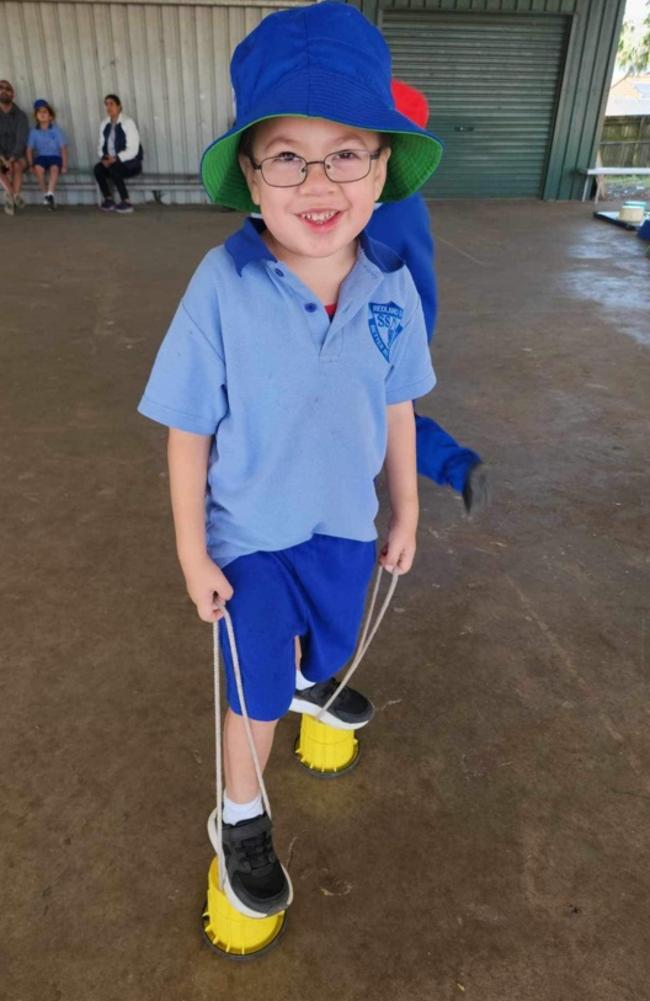Redland Bay schoolboy Kace Ormsby ready for gruelling stem cell transplant after finding match in Spain
A Queensland family have gone to the four corners of the world to get lifesaving treatment for their young son, dying from a rare disease.

Local
Don't miss out on the headlines from Local. Followed categories will be added to My News.
A bayside family has gone to the four corners of the world to obtain lifesaving treatment for their young son, dying from a rare disease.
Redland Bay State School year 1 student Kace Ormsby was diagnosed at the end of May with Hunter syndrome, so rare that it affects one in 150,000 and only boys.
Mucopolysaccharidosis type II (MPS II), known colloquially as Hunter syndrome, attacks many parts of the body including skeleton, heart, lungs, liver, brain and is a progressively debilitating disorder, with reduced lifespan to average age of 10-20 years.
After the shock diagnosis, his devastated parents, Leighton and Averill, had the difficult task of deciding the future treatment, knowing there was no official cure for the deadly disease.

“We were told we had three options – one to do nothing and enjoy our time with him while we have him,” Mr Ormsby said.
“Or we could do Enzyme Replacement Therapy, which would swap out corrupt enzymes for good ones and would involve treatment every week for the rest of his life.
“Or the third option was to have a bone-marrow transplant which is what we chose.”
Kace’s treatment involves two to four months in hospital for chemotherapy and a bone-marrow transplant to help slow deterioration.
But the process was not as easy as booking in for a hospital room and operation.
The family had to find a suitable donor with a match for Kace’s good bone marrow and stem cells.
His parents and sister were only half matches.
Doctors applied to the National Bone Marrow Bank but there was no match.
Disappointment turned to desperation and the search was then turned to an international bone marrow bank.
“It was incredible, doctors traced the best match for Kace to stem cells from a child in Spain,” Mr Ormsby said.
“So we can finally start the process for Kace to have a bone-marrow transplant.”
Doctors sped up the process as soon as the bone marrow donor from Spain was found and fast tracked treatment to start this week.
The book- and superhero-loving primary school student will stay at the Children’s Hospital until about November and has already had an operation to fit a catheter into his chest where the chemotherapy will be administered in preparation for the transplant.
While Kace is an inpatient at South Brisbane, Mr Ormsby has taken time out from work as an installer to support his family.
Wife Averill is a full-time carer for the couple’s eldest daughter, Sia, 8, who also has a rare disease, Rett syndrome, and is wheelchair-bound and non verbal.
Sia is one in 10,000 girls to have the syndrome, a severe condition of the nervous system causing progressive loss of motor skills affecting all body movement and language, also with a shortened lifespan averaging 24 years.
The couple also has a third child, Mina, 4, a bright, friendly, caring sister who will be starting school next year but was not a bone marrow match for Kace.

Mina is very supportive of her big sister Sia, and has just learned that Kace has to spend some time in hospital.
Niece Sophie Dale said the odds of the couple having two children with non-related, very rare, degenerative disorders was inconceivable and heartbreaking. “There is no effective treatment for Sia,” Ms Dale said.
“And now to buy back health and time with Kace, Leighton must take leave without pay from work for up to four months to stay with him in hospital while he receives treatment.
“During this time they will have little to no income.”
That equates to $13,500 for the possibility of an extra two months in hospital, along with income loss, daily parking and travel expenses to South Brisbane and $2000 for weekly post-transplant hospital visits for up to 12 months.
Ms Dale and her mum, Pam, started a campaign using online crowd funding group GoFundMe to raise money to support the family.
Mr Ormsby said it took six years to get Kace correctly diagnosed.
The couple had noted slight deviations in his learning ability compared to other kids his age and a prep teacher at his school at Redland Bay recommended remedial classes.
The active little boy had difficulty gripping objects with his hands and also snored at night.
His diagnosis followed a visit to an ear nose and throat specialist who referred Kace for diagnostic tests.

The tests were a suggestion from a pediatrician who was caring for big sister Sia.
After many months of waiting, it was that suggestion that put the family on the fast track to surgery and finding a solution.
“It’s all happened so quickly since then and we can look back and see all the little things we had noticed do add up,” Mr Ormsby said.
“Finding a stem cell match from umbilical
cord in Spain was amazing and that was flown in to Australia this week, ready for the transplant.
“We don’t know what lies ahead and that is a concern but we have family who flew in from New Zealand last week and a support group and the school has been wonderful.”
Redland Bay State School parents joined forces to raise some money for the family so Mr Ormsby could take time out of work while his son is in hospital.
More donations are needed for the ongoing treatment after the operation with a GoFundMe site set up to help the family here: https://www.gofundme.com/f/help-kaces-rare-disease-treatment
More Coverage
Originally published as Redland Bay schoolboy Kace Ormsby ready for gruelling stem cell transplant after finding match in Spain





